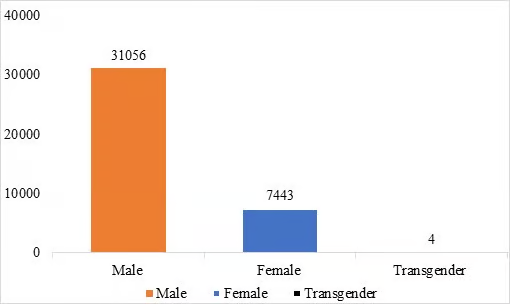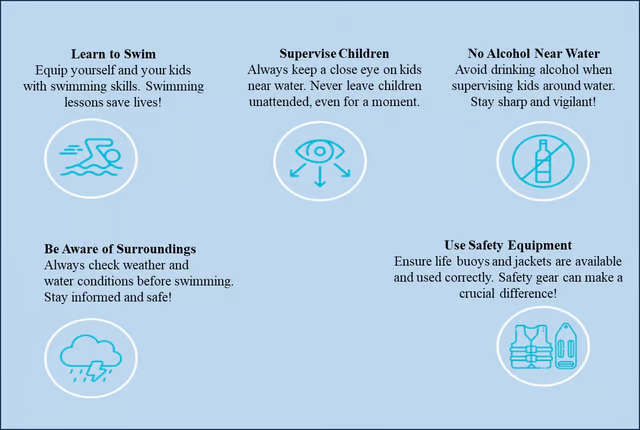Drowning Disasters in India | 02 Aug 2024
For Prelims: Drowning, Floods, Natural disasters, National Disaster Management Authority, Extreme weather events.
For Mains: Framework Related to Disaster Management in India, Factors are Exacerbating India’s Disaster Risk.
Why in News?
Recenlty, 25th July 2024 was observed as World Drowning Prevention Day. It is a global initiative that is dedicated to raising awareness and accelerating action on global drowning prevention.
- Drowning is a major public health problem that has caused over 2.5 million deaths in the last decade, mostly in low- and middle-income countries.
Drowning:
- As per World Health Organisation (WHO), drowning is defined as respiratory impairment resulting from submersion or immersion in liquid, with outcomes classified as death, morbidity, or no morbidity.
- World Drowning Prevention Day:
- It is an annual global event held on 25th July to honour those who have lost their lives to drowning and to promote water safety awareness.
- Established by a United Nations General Assembly (UNGA) resolution in April 2021, the event is coordinated by the World Health Organization (WHO).
- Theme for 2024: "Anyone can drown, no one should"
- WHO Slogan: "Seconds can save a life".
What are the Factors Contributing to Incidents of Drowning in India?
- Access to Water Bodies: Many Indians live near rivers, ponds, and wells for daily activities, lacking safety measures and supervision, especially for children.
- Flooding: Monsoon rains cause flooding, worsened by poor drainage, making communities vulnerable to drowning.
- Cultural Perceptions: Some communities view drowning as inevitable, hindering safety measures and awareness campaigns.
- Economic Constraints: Poverty limits access to safety equipment, swimming lessons, and emergency services, affecting low-income families in high-risk areas.
- Inadequate Safety Regulations: There is a lack of stringent safety regulations governing the use of public water bodies.
- Enforcement of safety measures, such as lifeguards at beaches and swimming pools, is often lacking, contributing to higher drowning rates.
What are the Statistics Related to Drowning Deaths?
- Global Data:
- Global Mortality: As per WHO Report on Drowning 2014, Drowning is a serious and neglected public health threat claiming the lives of 3,72,000 people a year worldwide.
- Regional Disparities:
- Low- and middle-income countries account for over 90% of unintentional drowning deaths. This death toll is almost two-thirds that of malnutrition and well over half that of malaria.
- More than half of global drowning incidents occur in the WHO Western Pacific and South-East Asia regions.
- Drowning death rates in the WHO Western Pacific Region are 27–32 times higher than those in the UK or Germany.
- Scenario for India:
-
Data: Around 38,000 Indians die of drowning every year.
- Drowning a Significant Concern: According to the National Crime Records Bureau (NCRB) report for 2022, drowning is a significant public safety concern and accounted for 9.1% of all accidental deaths in India, with 38,503 fatalities.
- State-wise Data: Madhya Pradesh reported the highest number of drowning deaths at 5,427, followed by Maharashtra (4,728) and Uttar Pradesh (3,007). This indicates a widespread issue across multiple states.
- Gender-wise Drowning Deaths:
-
Role of WHO in Addressing Drowning Incidents
- The World Health Organization (WHO) has recognised drowning as a leading cause of injury-related death and disability worldwide.
- Drowning deaths have emerged as a significant public health issue, gaining international attention with the WHO's first Global Report on Drowning Prevention in 2014.
- The WHO Resolution WHA76.18 emphasises the need for coordinated multi-sectoral action to combat this issue.
- WHO Recommendation for the Prevention of Drowning Accidents:
What Measures Can be Implemented to Prevent Drowning Incidents?
- Installation of Barriers: Erecting physical barriers around water bodies such as pools, wells, and ponds can significantly limit access, particularly for young children.
- Fencing and secure covers act as primary preventive measures to control entry to potentially hazardous areas.
- Safe Areas Away from Water: Creating designated safe zones for children and adults away from water bodies helps minimise the risk of accidental drowning. These areas should be equipped with engaging activities to divert attention away from water.
- Training in Rescue Techniques: Educating bystanders in safe rescue and resuscitation techniques, such as Cardiopulmonary Resuscitation (CPR) and mouth-to-mouth breathing, can save lives. Community programs should focus on training individuals to respond effectively in emergency situations.
- Integration into Education Curriculums: Incorporating water safety education into school curriculums ensures that children learn preventive measures from a young age.
- Enforcement of Boating Regulations: Implementing and enforcing strict boating and shipping regulations is essential. This includes mandatory life jacket use, regular maintenance of vessels, and adherence to safety protocols to prevent accidents on water.
- Flood Risk Management: Improving flood risk management through the development of flood-resistant infrastructure and early warning systems can significantly reduce the incidence of drowning during flood events. Local authorities should invest in such systems to enhance community resilience.
Conclusion
Drowning is a preventable tragedy that demands urgent attention in India. By understanding the socio-economic and environmental factors contributing to drowning incidents and implementing targeted interventions, we can significantly reduce the number of fatalities. Collaborative efforts involving government bodies, NGOs, and local communities are essential to creating a safer environment for all, particularly for vulnerable populations such as children. Addressing this silent disaster requires a comprehensive approach, ensuring that no life is lost to drowning.
|
Drishti Mains Question: What are the factors contributing to increasing deaths due to drowning in India? What measures should be taken to deal with this? |
UPSC Civil Services Examination Previous Year Question (PYQ)
Mains:
Q. Discuss the recent measures initiated in disaster management by the Government of India departing from the earlier reactive approach. (2020)
Q. Vulnerability is an essential element for defining disaster impacts and its threat to people. How and in what ways can vulnerability to disasters be characterized? Discuss different types of vulnerability with reference to disasters. (2019)
Q. Describe various measures taken in India for Disaster Risk Reduction (DRR) before and after signing ‘Sendai Framework for DRR (2015-30)’. How is this framework different from ‘Hyogo Framework for Action, 2005’? (2018)




